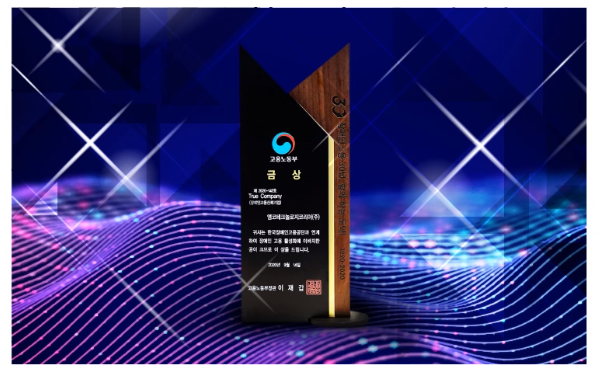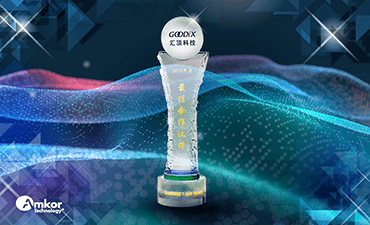Meeting the Challenges of 5G RF Production Test Services
Implementation of the 5G radio frequency (RF) standard is increasing rapidly [1]. Over the past four to six quarters, there has been an increased focus on publications and products that have been introduced to the marketplace. Some of the more popular RF eco-system applications include cellphone, WiFi, automotive, Internet of Things (IoT), location services, and more. WiFi and cellphone services are data-intensive, while IoT, in some cases, might require a limited amount of data.
基于4G移动网络的单位音量指标,实现图1和总可寻址市场(TAM)与5G标准定义的置信水平似乎很高。

Figure 1:Strong growth is predicted for 5G products.资料来源:物联网商业新闻.
有很多类似的地块,从全球地理区域开发产品到5G规格,有大量的图。预计较高的5G射频单元体积将导致测试较高的单位体积。预计基础设施的开发和部署预计将在用户设备介绍之前。如图2所示,典型的手机应用包括具有手机塔的基站,每个基站支持覆盖区域中的多个用户的手机。

Figure 2:双向RF通信框图的关键成分包括应用处理器(AP),基带集成电路(IC)和射频集成电路(RFIC)。
由于基站具有支持多个用户设备的覆盖区域,因此RF功率要求相对于用户设备更高。基站通过插入电源供电,而用户设备则设计为功率效率,因为它们是移动和电池供电的。由于在典型的手机上下载的数据的大小是比上载数据高的数量级,因此接收信道的数量通常大于发射信道的数量。在协议层采用多输入,多输出(MIMO)和载波聚合(CA)[1]等概念,以增加有效带宽。接收通道使用多样性[1]以提高空间性能。尽管这些概念不是本文的直接焦点,产品架构和设计确实对测试要求和测试方法产生了影响。基于WiFi技术的应用通常在家庭/办公室内。它们的最大RF功率是有限的,但动态范围不是,并且它们的带宽相对于手机通常更高。
最近引入5G 3GPP标准[1],识别两个单独的载波频谱中的载波频率。如图3所示,FR1载波频率位于410MHz至7.125GHz范围内,并且FR2载波频率位于24 GHz至52GHz范围内。允许带宽超过100 MHz,最高可达2 GHz。子载波间隔是压实的,因此需要对相位噪声进行更严格的约束,并获得平坦度。
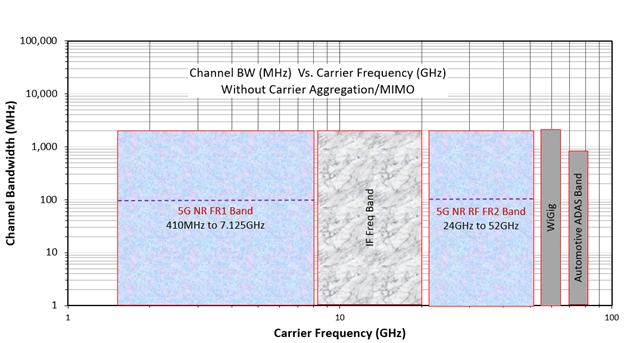
图3:在3GPP规格[1]中定义了5G载波频率。
5G New Radio (NR) Modulation Schemes
有两个5G NR信号调制方案 - 循环前缀正交频分复用(CP-OFDM)和离散傅里叶变换扩展正交频分复用(DFT-S-OFDM)[1](图4)。
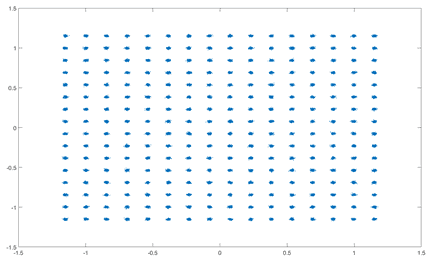
图4:A 256 quadrature amplitude modulation (256-QAM) 5G NR constellation plot captured on an Advantest V93K.
CP-OFDM is for downlink (D/L), with quadrature phase-shift keying (QPSK), 16-QAM, 64-QAM, and 256-QAM. It has high spectral efficiencies and is compatible with MIMO and 4G LTE definitions. DFT-S-OFDM is for uplink (U/L), with π/2- binary phase-shift keying (BPSK), 16-QAM, 64-QAM, and 256-QAM. It has a more complex implementation and has less flexible resource assignments compared to CP-OFDM and it is not used in combination with MIMO. The five sub-carrier spacings for 5G NR are between 15 kHz to 240 kHz. Figure 4 shows a 256-QAM plot.
5G RF Products & RFIO
现代直接和外差转换器架构[2]具有数字基带I / O.数字基带将数据馈送到数字到模拟转换器(DAC),该转换器(DAC)创建模拟同步和正交(I / Q)波形。当与本地振荡器(LO)信号混合时,这些波形,上转换数据以产生被发送到接收器(Rx)的调制中频(IF)或RF信号。信号传输在同轴屏蔽电缆上或空气中发生。在传输之前,特别是当它在空中时,信号可能需要信号放大。而且,接收器可以在为下转换提供信号之前要求接收的信号放大。下转换信号被馈送到模数转换器(ADC),该模数转换器(ADC)将信号转换为数字基带进行数字基带以便由应用处理器处理。图5显示了这些步骤。

图5:简化的发射器(TX)和RX RF链块。
集成设备制造商(IDM)客户为组装和测试服务带来各种RF产品。这包括,并且不限于收发器,低噪声放大器(LNA),功率放大器(PA),数字步衰减器(DSA),滤波器和混频器。根据目标应用程序,RF输入和输出通道的数量可能是不同的。带宽,相位噪声,互调失真(IMD),相位和幅度分辨率/精度以及其他测试要求也可能变化。
用于生产测试的测试设备(DUT)发射器特性规范包括传输功率和RF频谱排放(占用带宽,带宽,带宽排放,相邻信道泄漏比(ACLR)和IMD)。DUTS接收器的生产测试特性规范包括接收灵敏度,最大输入电平,相邻信道选择性,阻塞,虚假响应和IMD [1]。
Automated Test Equipment (ATE) Tester & Tooling with 5G RF Sub-systems
Advantest, Teradyne, National Instruments, and Cohu have recently publicly released an upgrade path for their mature ATE offerings. Amkor utilizes ATE’s RF sub-systems hardware and software instrumentation infrastructures to test customer products in production factories.
ATE vendors typically architect a universal superset configuration of instrument resources for customer test application development. The number of arbitrary waveform generators (AWGs), digitizers (DGTs), LOs, filters, amplifiers, tone combiners, transmit signal splitters, receive signal switches and their wide bandwidth and dynamic range of operation present trade-offs that must be considered for every new 5G RF application for each customer. Phase noise at application-specific frequencies and amplitudes from the instrument design has a direct impact on the error vector magnitude (EVM) test. Phase noise of -110 dBc/Hz at an offset of 100 kHz and -10 dB or better is acceptable (typical) at 5G range of continuous wave (CW) frequencies. In typical broadband customer product applications, there is a need to switch frequencies and amplitudes. Switching times impact the overall test list execution times. Testers with the smallest switching times are the most efficient in production testing. Figure 6 shows an ATE block diagram.
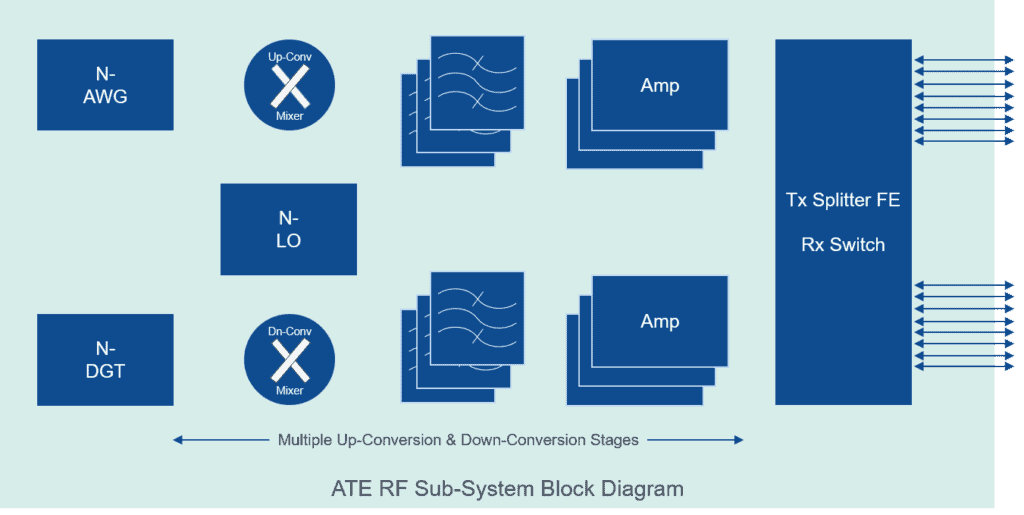
图6:A simplified ATE block diagram.
必须开发自定义工具(探测卡和/或装载板),以帮助将测试仪资源路由到设备,引脚或凹凸。对于晶圆探头服务,探针卡供应商提供探头引脚技术。对于50 GHz高于50 GHz的5G RF载波频率,挑战包括阻抗匹配和引脚,以引脚和站点到站点信号隔离。适用于封装部件,装载板,插座和插座销技术供应商提供引脚技术。对于5G RF载波频率,挑战类似于用于探针引脚的挑战。这些频率下的可接受水平的插入损耗(S参数S21)通常不超过-10dB,并且频率范围内的返回损耗(S11)通常优于-10dB。在频率范围内,典型应用的销钉隔离的可接受水平优于-45dB。
RF performance and accuracy specifications are guaranteed by the supplier to the test head signal delivery interface. The tester supplier develops and delivers calibration systems (hardware and software) to calibrate, verify, and diagnose performance within documented specifications. RF instruments’ accuracy specifications are sensitive to temperature fluctuations. In most cases, a ±5°C (or tighter) change in temperature triggers the instrument’s self-calibration routines. Power, signal (digital, analog/RF), and clocks require moving the calibration plane from the test head to the device pin. This path includes the traces on the probe card or load board. We have a unique benefit of either employing de-embedding techniques and using loopback or custom-developed Short, Open, Load, Through (SOLT) structures to help deliver the required RF signal accuracies to the device under test. Developing custom standards for calibration in most cases requires additional efforts, however, with in-house package designs, the avenue does exist. In most cases, golden loopback DUT techniques have been sufficient to achieve the desired accuracies.
Assembly-Test Attach
Our Assembly and Test divisions work closely to enable 5G RF engineering development followed by production testing. The benefit is a complete assembly and test turnkey solution offered from the same factory location. 5G packages offering antenna in package and antenna on package (AiP/AoP) SIP were first produced by Amkor in July 2018 and announced in a public press release in 2019 [3].
With the recent advancements in assembly and packaging technologies, RFICs, like 5G transceivers and RF Front End (RFFE) devices, may have antennas embedded within the package. Similarly, System in Package (SiP) devices have integrated relevant components like processor, memory, RFIC peripherals, discrete components including power amplifiers, low noise amplifiers, phase arrays, and antenna structures within the IC package [4]. The antenna forms the critical component of the front-end and requires tuning for the specific frequency band of operation. The 5G NR FR2 compliant customer products being designed today have their performance-tuned in specific operating bands, as defined in the 3GPP specification [1]. Data-intensive applications may warrant packing multiple radios within the package and hence the need for multiple antennas tuned per frequency band of operation.
All production testing of previous and present generations of RF devices has been conductive. RF I/O from and to the DUT are electrically connected with impedance-controlled paths over cables and shielded printed circuit board (PCB) micro-traces to the tester’s RF instrumentation. As described above, all ATE suppliers developing 5G RF test solutions include a conductive RF coaxial interconnect. To enable high-volume production testing of packages with an embedded antenna, the test methodology requires an interconnect that can transmit or receive RF energy with minimal and controlled signal loss. Antenna transmission theory [7], requires minimal spatial separation between the transmitter and the receiver. This separation depends on the carrier frequency. The number of RF I/O channels and multisite test requirements add to the production test complexity. The test options that are presently being explored, include patch and horn antennas, beamforming ICs (BFICs), embedded directional couplers, and waveguides. None of these solutions is high-volume manufacturing friendly nor are they scalable as the number of antenna increases. This is primarily due to the physical space requirement in the handler at the tester interface.
IDMS一直在架构设计结构,允许卓越(DFX)模式的Loopback设计,以帮助简化和生产经济的生产测试设备要求。虽然嵌入在包内的天线提供增加的小型化和整体集成,但它确实带走了用于载波频率的新5G NR操作带的应用程序的最终性能调整的灵活性。该公司继续与供应商和客户合作,解决生产测试的超空气(OTA)测试挑战。
Value-Added Proposition
在高水平,有两个主要生产测试操作模型。第一个有客户完成对测试内容的完全控制,包括托管所选的5G RF测试设备,并使用AMKOR执行生产运行。第二个测试操作模型具有客户要求工程服务,以实现生产测试。在这种情况下,我们的测试开发团队与客户密切合作,并迎合每个客户测试开发工程(TDE)要求的自定义需求。值 - 添加TDE服务的示例包括但不限于:
- 选择匹配的5G支持测试仪,
- 选择匹配的探针和/或处理程序,
- 设计匹配的5G测试工具(探针卡,装载板),以实现适当的测试仪资源分配,尤其是对于多站点生产测试,
- Developing and debugging production test programs, test patterns, and test waveforms per the customer’s functional test specification,
- Product qualification,
- Product characterization test routines,
- 产量优化、低屈服失效分析,一个d product design feedback. (Failure analysis may, for example, require X-ray or de-lamination to determine the root causes of fabrication and assembly packaging defects.),
- 自定义后端流动,也可以高效地处理成品。
RF测试开发工程集团具有显着的经验开发测试解决方案和用于前几代RF技术的测试内容,并继续建立在这种专业知识,以解决此处描述的5G测试挑战。本集团在FR1和FR2 RF光谱中积极参与创建和提出基站和移动5G RF产品的测试解决方案。这些测试解决方案利用上述3GPP标准兼容的ATE硬件和软件测试工具。
Internal production test processes have matured over the years and allow the implementation of design for manufacturing (DFM) rules to 5G RF production testing. Collecting, analyzing, and retaining manufacturing test results of 5G RF production tests is vital for incremental improvements to test methods, flows, and content. In specific cases, test engineers provide valuable feedback to the IC design and fabrication process engineers. Established statistical bin limits (SBL) for 5G RF test results for multisite across the test equipment fleet can help identify systemic equipment-related false failures and help with the elimination of such factors. This ensures optimal test equipment utilization and improves the overall production throughput.
客户的一部分优惠都有具有临时上市时间(TTM)目标的产品,对知识产权(IP)污染和安全性敏感。成熟的系统和流程到位,以处理所有这些客户的担忧。
AMKOR生产测试一直在准备测试未来几年预计的大量5G产品。这包括预期用户设备(移动设备)增长的5G基站和基础设施设备。
概括
5G RF生产测试业务的规模很大,迅速增长。我们的生产测试团队一直与装配包装,ATE供应商和客户密切合作,以确保整体5G RF生产测试服务可用于满足并超出所有测试能力和容量挑战。
参考
- 3GPPTS 38.101-1 V16.1.0 (2019-09).
- 宽带射频架构选项 - Peter Delos,模拟设备.
- amkor设备包
- 包装/天线上的天线
- Amkor Antenna in Package –Article.
- Amkor Coplays - 2019年新闻稿
- Fresnel Far Field Region或者天线理论
关于作者
老主任Vineet Pancholi测试Technology at Amkor Technology, Inc. in Tempe, AZ. Vineet joined Amkor in January 2019 and currently leads test technology development for 5G RF and high-speed digital production test methodologies. Before joining Amkor, Vineet worked in test development at Microchip Technology. Prior, he spent 19 years at Intel in a variety of test roles, including tester supplier management, test technology development (burn-in, final and system level test) and RF tester architect. Vineet holds a patent on semiconductor device testers and has earned master’s degrees in physics and electrical engineering from Arizona State University.

